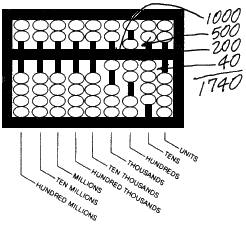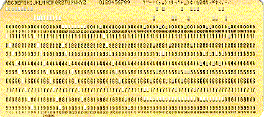The Abacus
When humanity wanted to increase his or her capacity to add beyond counting on fingers, making marks on walls, or grouping rocks, machines were developed. One of the oldest devices was the abacus which was developed around 2000 B.C. This machine is still used in Japan, China, and other Asian countries. | The abacus, an early forerunner of the computer, has been in existence for 4000 years. In the example to the left, the number 1740 has been entered in the abacus. The abacus consists of several fixed vertical rods strung with moveable beads within a rectangular frame and with a horizontal bar across the rods. Each of the two beads above the cross bar have a value of five and each of the five beads below the cross bar have a value of five and each of the five beads below the cross bar have a value of one. Beginning on the right hand side and moving left; the first rod represents the units digit, the second rod represents the tens digit, then follows the hundreds digit, thousands digit, and so on. The abacus is cleared or set to zero by moving all beads away from the cross bar. Numbers are entered by moving the appropriate beads to the cross bar, beginning with the rightmost digit and working left. A very efficient abacus user can keep up with, or even beat, a person using a mechanical calculator when both are adding the same columns of figures. |
Mechanical CalculatorsAlthough the abacus worked very well, and still does, humanity continued to search for better and faster machines to do his or her calculations, since this was the tedious and time consuming part of mathematics. In 1617 John Napier, a Scottish mathematician, described the use of specially marked rods to perform multiplication and division. The rods were carved from ivory and were often referred to as "Napier's Bones". (His work in mathematics led to the much later development of the slide rule, the primary "machine" for complex calculations for many years.). | In 1642, the brilliant Frenchman Blaise Pascal invented the first actual "adding machine" which resembled the mechanical desk calculators that were popular in the 1960's. It was a complex arrangement of wheels, gears, and windows for displaying the numbers. Today a popular computer programming language is named after him in his honor. A more advanced machine of similar kind was developed in the late 1600's by the German genius Gottfried Leibnitz. His machine could mechanically add, subtract, multiply, divide, and even extract square roots. |
In the early 1800's, several people contributed to major advances in humanity's continuing quest for calculating machines that could do more. One contributor, although not primarily interested in mathematics, was Joseph Jacquard. He invented a loom for weaving cloth that was controlled by instructions that were stored in code on punched cards. This idea of punched card storage was used to store both instructions and numbers or data by Charles Babbage. In 1835, he invented a mechanical mathematical digital computer that was called an "analytical engine." He used the punched cards to program his machine, which was capable of using the results of one calculation as input for another calculation, and was capable of handling repetitive calculations or loops. An even more significant accomplishment of the analytical engine was the capability to jump around the program instructions rather than taking them in the entered sequence. | In the 1890's Herman Hollerith developed the punched card and the Hollerith code for the card punching sequence. He set the groundwork for a company that later evolved into International Business Machines (IBM).
In the 20th century the punched card above, often called an "IBM card," had holes located in coded patterns with a unique code for each number or letter. The original cards were punched by a key-punch machine in response to an operator's input on a typewriter-like keyboard. |
Electro-Mechanical ComputersWith electricity commonly available, people began developing electro-mechanical machines rather than purely mechanical ones. An electro-mechanical device is one that uses electricity to produce mechanical movement, using the relay and the solenoid. The first electro-mechancial computer, called the Mark I, was developed by Howard Aiken and others at Harvard University in 1944. It was 51 feet long (15.5 meters) and 8 feet high (2.4 meters). Instructions were fed in on punched paper tape and data was input on punched cards. The output results were recorded on cards by an electric typewriter. The Mark I could multiply two numbers in about three seconds. In 1947, the Mark II could perform the same multiplication in about one-fourth of a second (12 times faster). Today computers can perform hundreds of thousands of mathematical calculations in one second. | Electronic ComputersThe electronic age got under way with the vacuum tube. In the first television sets, the vacuum tube was usually the culprit that caused your TV to quit right in the best part of your favorite program. It is that glass bulb, heated by a filament, in which electrons flow from cathode to anode in a vacuum. The first electronic digital computer used vacuum tubes and could perform multiplication in about 2.8 milliseconds. This machine, the ENIAC, an acronym for Electronic Numerical Integrator and Computer, was developed by J. Presper Eckert, John W. Mauchly and others at the Moore School of Engineering at the University of Pennsylvania in 1946. The U.S. Army Ordance Corps used ENIAC to calculate artillery firing tables. Operators programmed the ENIAC by manually changing plug-in connections and setting switches which required a lot of time. |

